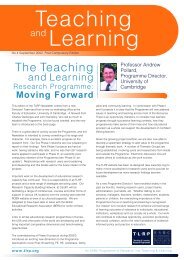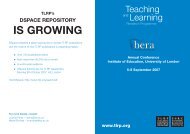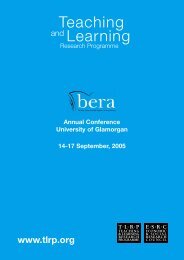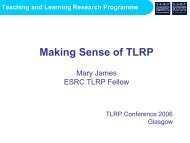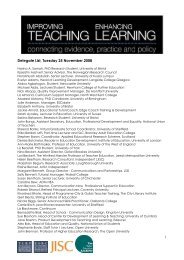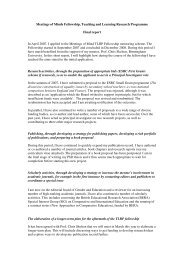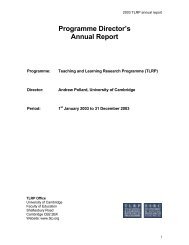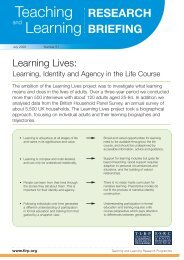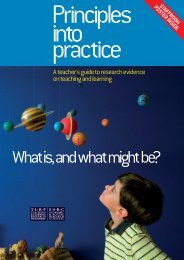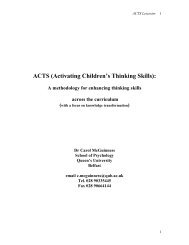Education 2.0? - Teaching and Learning Research Programme
Education 2.0? - Teaching and Learning Research Programme
Education 2.0? - Teaching and Learning Research Programme
- No tags were found...
Create successful ePaper yourself
Turn your PDF publications into a flip-book with our unique Google optimized e-Paper software.
<strong>Education</strong> <strong>2.0</strong>?<strong>Learning</strong> <strong>and</strong> virtual worldsDiane CarrVirtual worldsThe term virtual world refers to a computer-based environment, <strong>and</strong> encompasses online games such as Worldof Warcraft as well as social worlds such as Second Life. Virtual worlds play host to collaboration, creativeproduction <strong>and</strong> dissemination, socialising, role-play, programming <strong>and</strong> building. There are significant differencesbetween online multiplayer computer games <strong>and</strong> social worlds, but educators are interested in the two forsimilar reasons, including their capacity to immerse <strong>and</strong> motivate learners, <strong>and</strong> the potential to alter a user’srelationship to technology. 1Games generally involve rules <strong>and</strong> goals. Yet multiplayer games are not predetermined, rule-bound experiences.Recent qualitative <strong>and</strong> quantitative research has helped to reveal the complexity of online game worlds. 2 Play inpopular MMORPGs (Massively Multiplayer Online Role Playing Games) emerges across an elective spectrum.Games such as World of Warcraft do accommodate virtual combat <strong>and</strong> overt goals, but they also support thepleasures associated with exploration, chat, experimentation, improvisation, humour <strong>and</strong> role-playing. Onlinegaming involves playing within parameters (provided by rules or virtual physics, for example) but it also involvesplaying with these constraints. From trading, dancing <strong>and</strong> consensual duelling, to player-versus-player ambush,online games come to life through the actions <strong>and</strong> prerogatives of participants. Even combative, goal-orientedplay involves players providing social support in the form of ‘clans’ <strong>and</strong> ‘guilds’, collaboration <strong>and</strong> mentoring.<strong>Learning</strong> is central to playing an online game. But those with an interest in teaching are more likely to be drawnto social worlds such as Second Life. What Second Life offers that the current alternatives do not is a relativelystable <strong>and</strong> accessible, inexpensive <strong>and</strong> inhabited, persistent world where it is possible to build simulations ofprocesses (biological or geological, for instance), as well as locations such as a cinema, a habitat or a campus.To begin to explore Second Life it is necessary to design an ‘avatar’ - a personification in the virtual world.This avatar is named, but its gender <strong>and</strong> species can be switched. It might change from an elderly librarian toa rabbit or a robot. While in Second Life I might choose to explore, or I can focus instead on learning to makeh<strong>and</strong>bags, scooters, horses or houses. I can write or buy scripts (programming) that will enable my avatar toperform simple animations, <strong>and</strong> thus exp<strong>and</strong> its (<strong>and</strong> hence my) expressive repertoire. In the guise of my avatarI can run a business <strong>and</strong> meet other ‘people’ at conferences, in nightclubs or at gallery openings. I might act infilms that are shot in-world (known as ‘machinima’) or collaborate in the construction of a neighbourhood.As this list of possible activities suggests, there is one Second Life, but many ‘second lives’. Second Life is atoolset, a virtual world, <strong>and</strong> it supports social networks. It is not a game, but it is a platform for play, <strong>and</strong> a placewhere people might gather to build or play games. While users might not be confronted with a set of gamerules, there are constraints in place, including the developer’s Terms of Service, as well as community etiquette.While there might not be a specified mission or goal, there are goal-oriented practices <strong>and</strong> values includingsocial approbation <strong>and</strong> reputation.Some educators planning sessions in a virtual world such as Second Life focus on technical aspects (runningclasses on scripting, for example), or building <strong>and</strong> testing simulations. Others might exploit its creative or socialaspects, or use Second Life to teach specific content (geology or geography, for instance) through discussion,demonstration or practical exercises. Other teachers <strong>and</strong> students might see Second Life itself as a cultural ortechnical phenomenon deserving of study. Some might simply regard the virtual world as a convenient locationfor a class meeting.13



